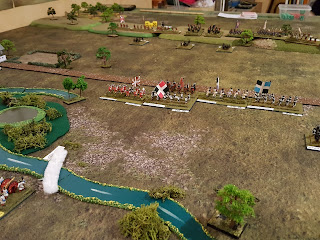These are quite innovative. Highlights:
- Your force has a burnable resource, by 'command' (left, centre, right).
- It's very hard to keep inertia flowing in the attack, and reacting to the opponent burns resource even more.
- When you run out of dice to respond, it becomes difficult to react, and the opponent can take the initiative.
- Where you can gather d6 to roll vs opponent's roll, it always helps - be they resource, bonus, or command dice - but it's an attritional mechanism.
This, on the face of it, is a superb mechanic, as you constantly have to manage the force and nurse it along to ensure that (1) you have enough dice to respond to attacks while (2) ensuring that the units actually do something and maintain a line/attack.
Now, you'd think I would love this, being attracted to 'manage your resources to manage the battle' style games, and I can see the merits of the system. Although, being the first game, I used up my resources far too quickly, and found myself fighting the rules rather than the battle. But certainly one for additional plays, and seems to reflect the WSS quite well. It certainly makes you think about husbanding resources.
It's definitely less 'gamey' than say Maurice or Field of Battle. That's not a bad thing - but does require a different way of thinking and planning.
Another game tomorrow - same battle - but with 'Field of Battle' (of course).
French right. I decided to launch an un-historical attack instead of defending against the allies. Well...it certainly tests the resource rules!
French left
Allied held high ground. Hmmm...not a chance of taking that with my flank open.
The battle was dominated by a cavalry action on the French right, which pretty much opened up the flank for the Allies.
The French, despite deciding to launch an attack, were inevitably going to run out of steam.
oh yes - sixes always help :)













Was first I had used DF in good while so not fully offay with the rules.
ReplyDeleteAs you say interesting concepts and the dicing systems for command, movement and combat are innovative but not sure it has the overall excitement level we get with other sets as a bit ‘stop an start’ ?
Yeah, though I thought long and hard about this - and I've probably been unfair. I think the design mechanism has a lot of benefits. With experience with the rules, I think it would certainly 'feel' like managing a battle. As you said, you can't do everything and that's fair.
DeleteThe excitement level I guess, from other sets, comes from the 'gamey' nature. Definitely worth trying again.
Lovely looking game as ever. This sort of resource management is always interesting but i find it very hard to find a system where it adds to the game without becoming the sole focus of the gaming experience. Dux Bellorum is possibly the closest I've found (limited experience mind) before the dice/ chits/ cards or whatever start taking away from the game. Always worth a second crack though.
ReplyDeleteYep - Sgt's 10mm stuff is beautiful.
DeleteIt's a tough balance - having said that, I wouldn't say that the rules became an exercise in accountancy, but definitely make you think differently about what/where to commit.
Fine looking game and I prefer less gamey in most situations. DF sounds interesting but to agree with Spinks, sometimes the tail wags the dog in these types of games.
ReplyDeleteYes exactly. I think it's easy to see how the rules have developed, and there is a certain genius at work there. It's a different mindset when playing, and though that probably unnerved me at the time, it's worth trying again.
DeleteResource management can often come come at a cost of intuitive feel for the subject and those that are too clever can feel like a process played for its own sake.
ReplyDeleteThanks Norm. Yeah - I'm not sure if Bob is trying to be too clever or trying to think about battlefield impetus/inertia in a different/more practical way. There is a certain 'energy' (term he uses) we read about in accounts, with regard to an army's ability to 'do stuff' in the battle. In FoB, it's a single army withdrawal resource which gets beaten down. In Die Fighting, resource gets chipped away when you want to do something in the turn, including responding to attacks - is that more realistic - quite possibly, though as you say, there's a game balance to find I guess.
DeleteNever heard of these rules, Darren. Checking them out tonight.
ReplyDeleteWorth a look Steve. Bob Jones created Piquet, from which Brent Oman devised Field of Battle, so there's a nice pedigree there.
DeleteDie Fighting is a really interesting design, with some very clever mechanics. Bob Jones has never been a fan of systems where everyone can act at the same time, and especially not predictably. You definitely have to think whether the actions you plan on are worth it. I think scenario design is a bit challenging with DF2 - if a player will be attacking, he is going to need significant advantages in troop numbers, or an initial resource dice bonus, or both. I really wish that Bob had published a few scenarios for the game! I think that would have really supported the game well. DF2 really developed and refined the concepts a lot from DF1, especially with his later revisions.
ReplyDeleteI agree completely. I see the design intent, but perhaps scenarios but complete the final piece of the puzzle and make the system and design mechanism very well rounded.
Delete